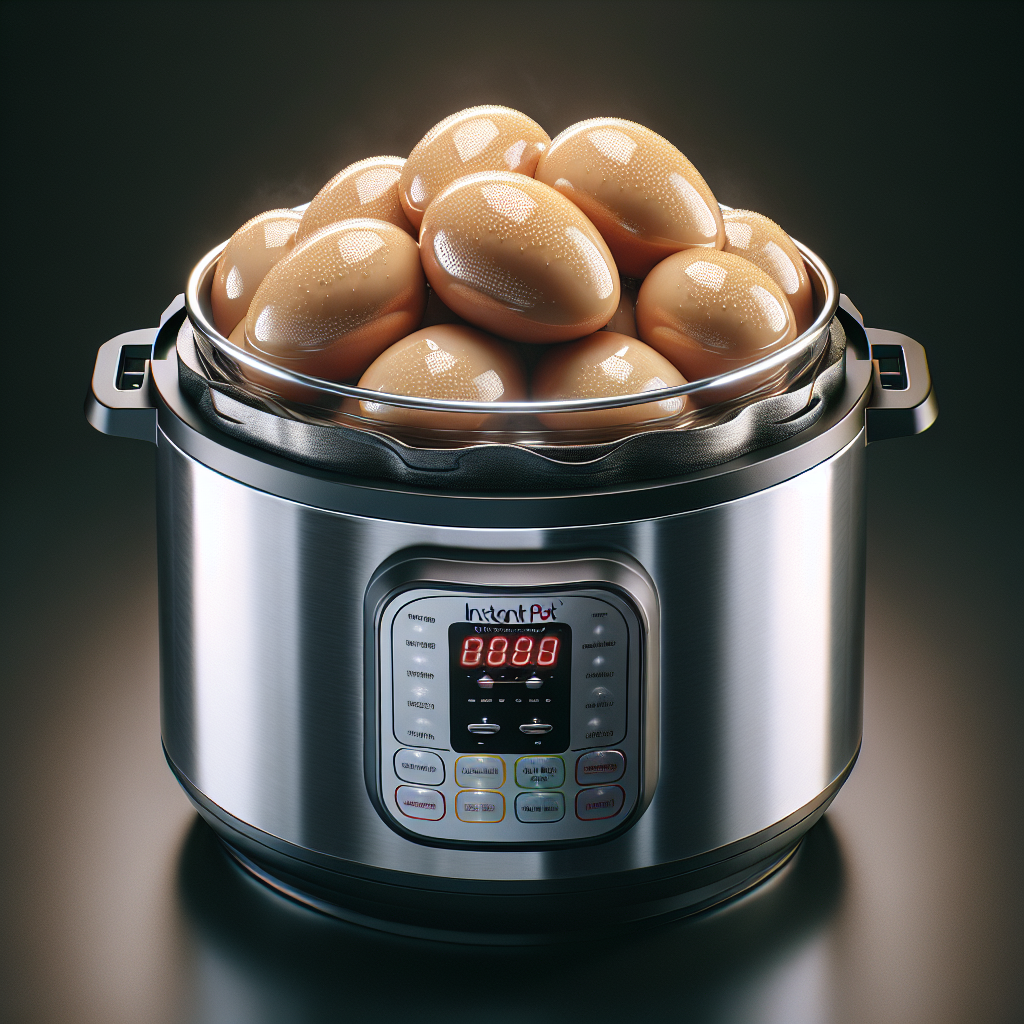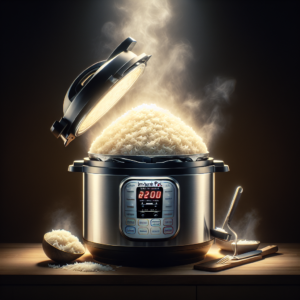Get ready to discover the perfect way to achieve perfectly boiled eggs every time with the help of your Instant Pot. Whether you prefer your eggs soft, medium, or hard-boiled, we have the foolproof method that will guarantee consistent results. Say goodbye to overcooked or undercooked eggs and hello to deliciously cooked eggs with a creamy and velvety yolk. Let us walk you through the simple steps to mastering the art of boiling eggs in an Instant Pot.

Boiling Eggs in Instant Pot
Boiling eggs can sometimes be a tricky task. It’s not always easy to achieve the perfect consistency and avoid those dreaded cracked shells. That’s where the Instant Pot comes in. This incredible kitchen gadget has revolutionized the way we cook, and boiling eggs is no exception. In this comprehensive article, we will walk you through the step-by-step process of using an Instant Pot to boil the perfect eggs. From selecting the right Instant Pot to enjoying your deliciously cooked eggs, we’ve got you covered.
How to Use Instant Pot for Boiling Eggs
Step 1: Select the right Instant Pot
The first step in boiling eggs with an Instant Pot is selecting the right model for your needs. Instant Pot offers a wide range of models, each with its own set of features. Consider factors like capacity, smart features, safety measures, accessories, and user reviews and ratings when choosing the perfect Instant Pot for your egg-boiling adventures.
Step 2: Gather the necessary ingredients
To boil eggs in an Instant Pot, you’ll need a few simple ingredients. First and foremost, you will need fresh eggs. Make sure they are not past the expiration date and are free from any cracks. Additionally, you will need water and, of course, your Instant Pot. To ensure easy removal of the eggs from the pot, consider using a trivet or a steamer basket. Lastly, don’t forget the ice for the final step of the process.
Step 3: Prepare the eggs
Before placing the eggs in the Instant Pot, it’s essential to prepare them properly. First, perform the freshness test by gently placing an egg in a bowl of water. If it sinks to the bottom and lays flat, it’s fresh and perfect for boiling. If it stands on one end or floats, it’s best to avoid using it. Next, wash the eggs under running water to remove any dirt or debris. Finally, pierce the rounded end of each egg with a pin or a needle. This will prevent them from cracking during the cooking process.
Step 4: Add water to the Instant Pot
Now it’s time to add water to your Instant Pot. The minimum water requirement will depend on the model you’re using, so be sure to consult the user manual. Generally, it’s recommended to add at least one cup of water to the pot. This will create the necessary steam for cooking the eggs.
Step 5: Place the eggs in the Instant Pot
After adding the water, carefully place the prepared eggs into the Instant Pot. If you’re using a trivet or a steamer basket, arrange the eggs on top of it. Make sure they are evenly spaced to ensure even cooking. Be careful not to overcrowd the pot, as this can affect the cooking time and result in unevenly cooked eggs.
Step 6: Set the cooking time and pressure level
Now it’s time to set the cooking time and pressure level. The optimal cooking time and pressure will depend on the desired doneness of your eggs. For soft-boiled eggs, a cooking time of 4 minutes at high pressure is recommended. For medium-boiled eggs, increase the cooking time to 5-6 minutes. And for hard-boiled eggs, cook them for 8-10 minutes. Adjust the pressure level according to your Instant Pot’s settings.
Step 7: Start the cooking process
Once you’ve set the cooking time and pressure level, it’s time to start the cooking process. Simply close the Instant Pot lid and ensure the steam release valve is set to the sealing position. Press the “Pressure Cook” or “Manual” button on your Instant Pot and adjust the cooking time if necessary. The pot will take some time to come to pressure before the actual cooking begins.
Step 8: Natural release or quick release?
After the cooking time is up, you have two options for releasing the pressure in your Instant Pot: natural release or quick release. Natural release involves allowing the Instant Pot to release pressure naturally over a period of time, typically 5-10 minutes. This method is preferable for delicate foods like eggs, as it helps prevent overcooking. On the other hand, quick release involves manually releasing the pressure by turning the steam release valve to the venting position. This method is faster but may result in slight overcooking of the eggs.
Step 9: Transfer eggs to an ice bath
Once the pressure has been released, carefully remove the lid from the Instant Pot. Using tongs or a slotted spoon, transfer the eggs to an ice bath. An ice bath is simply a bowl or basin filled with ice and cold water. Placing the eggs in an ice bath stops the cooking process and helps loosen the shells, making them easier to peel.
Step 10: Peel and enjoy
The final step is peeling and enjoying your perfectly boiled eggs. Gently tap each egg on a hard surface to create cracks, then roll it between your hands to loosen the shell. Start peeling from the wider end of the egg, as this tends to have an air pocket that makes peeling easier. Rinse the peeled eggs under running water to remove any shell fragments, and they’re ready to be enjoyed!
Choosing the Perfect Instant Pot
Capacity
When choosing an Instant Pot for boiling eggs, consider its capacity. Instant Pots come in various sizes, ranging from 3-quart to 8-quart models. If you plan on boiling a larger quantity of eggs at once or using your Instant Pot for other cooking tasks, a larger capacity model may be more suitable.
Smart features
Instant Pots with smart features offer added convenience and versatility. Look for features like Wi-Fi connectivity, programmable settings, and compatibility with smart assistants like Alexa. These features can enhance your cooking experience and make boiling eggs even easier.
Safety measures
Safety should always be a top priority in the kitchen. Look for an Instant Pot model that offers safety features like lid-locking, pressure release valves, and built-in sensors that prevent accidents and ensure worry-free cooking.
Accessories
Some Instant Pots come with additional accessories that can enhance your egg-boiling experience. Look for models that include a trivet or a steamer basket, as these can make it easier to place and remove the eggs from the pot.
User reviews and ratings
Before making your final decision, take some time to read user reviews and ratings of different Instant Pot models. These reviews can provide valuable insights into the performance, durability, and overall satisfaction of other users. Choose a model with positive reviews and high ratings to ensure a quality cooking experience.
Ingredients and Tools
Fresh eggs
When boiling eggs, it’s crucial to use fresh eggs. Fresh eggs not only taste better, but they also have a firmer texture and are less likely to crack during cooking. Check the expiration date on the carton and avoid using any eggs that have passed their prime.
Water
Water is an essential ingredient in the egg-boiling process. It provides the necessary moisture and steam to cook the eggs evenly. Ensure you have enough water to meet the minimum requirements of your Instant Pot, as specified in the user manual.
Instant Pot
Of course, you’ll need an Instant Pot to boil your eggs. Depending on your preferences and needs, choose the appropriate model that suits your cooking style and requirements.
Trivet or steamer basket
Using a trivet or a steamer basket can make the egg-boiling process easier. These accessories help elevate the eggs, allowing for even cooking and preventing them from sticking to the bottom of the Instant Pot.
Ice
Ice is the final ingredient in our egg-boiling recipe. Placing the boiled eggs in an ice bath after cooking helps stop the cooking process and makes peeling the shells easier.

Preparing the Eggs
Freshness test
Before boiling the eggs, it’s crucial to perform a freshness test. This simple test ensures that the eggs are suitable for cooking and will yield the best results. Fill a bowl with water and gently place an egg into it. If the egg sinks to the bottom and lays flat, it’s fresh and ready to be boiled. If it stands upright or floats, it’s best to discard it as it may not be fresh.
Egg washing
To remove any dirt or debris from the eggshells, it’s important to wash them before cooking. Simply hold each egg under running water and gently rub the surface to remove any impurities. Be careful not to use any detergents or soap, as this can affect the taste and safety of the eggs.
Piercing the eggs
To prevent the eggs from cracking during the cooking process, it’s advisable to pierce a small hole in the rounded end of each egg. This can be done using a pin or a needle. By piercing the egg, you allow any trapped air to escape, reducing the risk of cracks.
Water Levels and Ratios
Minimum water requirements
Every Instant Pot model has specific minimum water requirements for safe and effective cooking. It’s important to consult the user manual of your Instant Pot to determine the minimum amount of water needed. Adding less water than recommended can result in inadequate steam production, affecting the cooking time and results.
Water-to-egg ratio
In addition to meeting the minimum water requirements, it’s essential to maintain the appropriate water-to-egg ratio. As a general guideline, for every cup of water, you should use around 6-8 eggs. This ratio allows sufficient space and steam for the eggs to cook evenly.

Setting the Cooking Time and Pressure Level
Soft-boiled eggs
If you prefer your eggs with a soft, runny yolk, set the cooking time to 4 minutes at high pressure. This will result in perfectly cooked soft-boiled eggs, with the whites set but the yolk still slightly liquid.
Medium-boiled eggs
For a firmer, yet still slightly soft yolk, increase the cooking time to 5 or 6 minutes at high pressure. This will give you medium-boiled eggs with a creamy yolk that is not completely solid.
Hard-boiled eggs
To achieve fully cooked hard-boiled eggs with a solid yolk, set the cooking time to 8-10 minutes at high pressure. This will ensure that the yolk is fully set and the whites are firm throughout.
Natural Release or Quick Release?
Natural release method
Natural release involves allowing the Instant Pot to release pressure on its own, without any manual intervention. To use the natural release method when boiling eggs, simply let the Instant Pot sit for 5-10 minutes after the cooking time is up. During this time, the pressure will gradually decrease, and the eggs will continue to cook slightly.
Quick release method
Quick release, as the name suggests, involves manually releasing the pressure in the Instant Pot using the steam release valve. This method is faster but may result in slight overcooking of the eggs. To perform a quick release, turn the steam release valve to venting position using a long-handled utensil. Be cautious of the hot steam and follow the safety instructions provided by your Instant Pot.

Benefits of Using an Instant Pot
Time-saving
One of the biggest advantages of using an Instant Pot for boiling eggs is the time-saving aspect. The Instant Pot cooks eggs much faster than traditional boiling methods, reducing the cooking time significantly. This is especially beneficial when you have a busy schedule and need to prepare a quick and easy meal or snack.
Consistent results
The Instant Pot’s precise temperature control and sealed cooking environment ensure consistent and predictable results every time. You no longer need to worry about undercooked or overcooked eggs. With the Instant Pot, you can achieve the perfect doneness every time, be it soft-boiled, medium-boiled, or hard-boiled.
Easy cleanup
Boiling eggs on the stovetop often results in messy pots and pans. The Instant Pot eliminates this hassle by containing all the cooking and steam within its sealed chamber. After boiling eggs, all you need to clean is the Instant Pot insert and any additional accessories you used. This makes cleanup a breeze and frees up more time for you to enjoy your perfectly boiled eggs.
Versatility
While the Instant Pot is known for its egg-boiling prowess, it is a versatile kitchen appliance that can do so much more. From pressure cooking to slow cooking, sautéing, steaming, and even making yogurt, the Instant Pot is a valuable addition to any kitchen. Its versatility allows you to experiment with various recipes and cooking techniques beyond boiling eggs.
Conclusion
Boiling eggs in an Instant Pot is a game-changer. With its time-saving abilities, consistent results, and easy cleanup, the Instant Pot makes boiling eggs a breeze. By following the step-by-step instructions and selecting the right Instant Pot, you can enjoy perfectly boiled eggs with the desired doneness every time. So, why stick to the traditional stovetop method when you can simplify your egg-boiling process with the help of an Instant Pot? Give it a try and enjoy the convenience and deliciousness of perfectly boiled eggs, every time!





